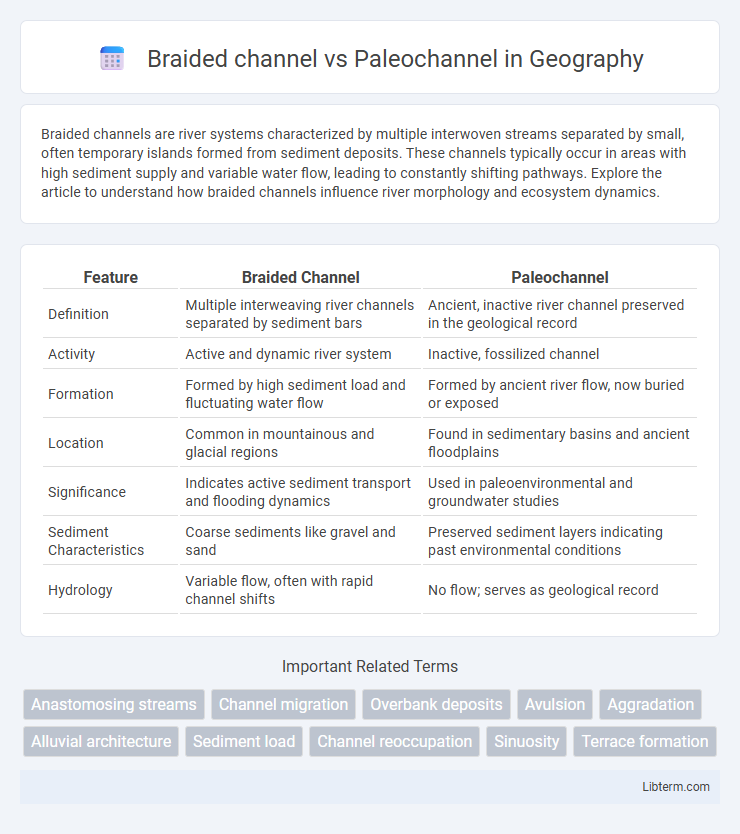Braided channels are river systems characterized by multiple interwoven streams separated by small, often temporary islands formed from sediment deposits. These channels typically occur in areas with high sediment supply and variable water flow, leading to constantly shifting pathways. Explore the article to understand how braided channels influence river morphology and ecosystem dynamics.
Table of Comparison
| Feature | Braided Channel | Paleochannel |
|---|---|---|
| Definition | Multiple interweaving river channels separated by sediment bars | Ancient, inactive river channel preserved in the geological record |
| Activity | Active and dynamic river system | Inactive, fossilized channel |
| Formation | Formed by high sediment load and fluctuating water flow | Formed by ancient river flow, now buried or exposed |
| Location | Common in mountainous and glacial regions | Found in sedimentary basins and ancient floodplains |
| Significance | Indicates active sediment transport and flooding dynamics | Used in paleoenvironmental and groundwater studies |
| Sediment Characteristics | Coarse sediments like gravel and sand | Preserved sediment layers indicating past environmental conditions |
| Hydrology | Variable flow, often with rapid channel shifts | No flow; serves as geological record |
Introduction to Braided Channels and Paleochannels
Braided channels consist of multiple interwoven streams separated by temporary sediment bars, typically found in areas with high sediment supply and variable water flow. Paleochannels are ancient river or stream channels that have been filled or buried by newer sediment deposits, preserving evidence of past fluvial activity. Understanding the distinction between active braided channels and preserved paleochannels is crucial for geological studies of sediment transport and landscape evolution.
Geological Formation Processes
Braided channels form through the deposition of coarse sediments in areas with high sediment supply and variable water flow, leading to multiple interwoven channels separated by transient bars. Paleochannels represent ancient, inactive river channels preserved in the geologic record, often buried by newer sediments and identified through subsurface imaging or sedimentological analysis. Geological formation processes of braided channels involve dynamic fluvial dynamics and frequent channel migration, while paleochannels result from historical shifts in drainage patterns, climatic changes, or tectonic activity causing channel abandonment.
Key Morphological Characteristics
Braided channels exhibit multiple interconnected, shifting channels separated by transient sediment bars, characterized by high sediment load and variable flow regimes. Paleochannels are ancient, inactive channel forms preserved in the subsurface or geomorphology, often identified by incised meandering or braided patterns filled with sediment deposits. Key morphological differences include active, dynamic sediment transport in braided channels versus static, lithified deposits and stratified sediment layers in paleochannels.
Sediment Composition and Distribution
Braided channels typically exhibit a heterogeneous sediment composition characterized by coarse-grained materials such as gravel and sand, distributed in multiple interlacing bars and channels due to high sediment supply and variable flow regimes. Paleochannels, as ancient river deposits, often show finer sediment layering including silt and clay, reflecting more stable and episodic sedimentation over time with well-preserved stratification. The sediment distribution in braided channels is dynamic and spatially variable, while paleochannels display more uniform vertical and lateral sedimentary deposits indicative of past fluvial processes.
Hydrological Dynamics and Flow Patterns
Braided channels feature multiple interlacing streams separated by sediment bars, causing highly variable flow velocities and frequent sediment redistribution, which enhances floodplain connectivity and dynamic sediment transport. Paleochannels represent ancient, buried river courses that influence current groundwater flow by acting as preferential pathways or barriers within aquifers, often preserving hydrological signatures of past climates. The hydrological dynamics in braided channels emphasize active surface water flow and sediment flux, whereas paleochannels primarily affect subsurface flow patterns and aquifer recharge processes.
Environmental and Ecological Significance
Braided channels, characterized by multiple interweaving streams and high sediment load, create dynamic habitats supporting diverse aquatic and riparian species by constantly reshaping the landscape. Paleochannels, representing ancient river courses filled with sediment, serve as important groundwater reservoirs and fossil records, offering insights into past climate and ecological conditions. Both features play significant roles in biodiversity conservation and water resource management, influencing local environmental stability and ecosystem functions.
Methods for Identifying Channel Types
Identifying braided channels versus paleochannels involves analyzing sedimentary structures, grain size distribution, and channel morphology using remote sensing techniques such as aerial photography and satellite imagery. Geophysical methods like ground-penetrating radar (GPR) and electrical resistivity tomography (ERT) help detect subsurface sediment patterns distinctive to paleochannels. Hydrological modeling combined with stratigraphic analysis further differentiates active braided channels characterized by multiple shifting bars from ancient paleochannels preserved in the sedimentary record.
Applications in Geology and Engineering
Braided channels, characterized by multiple interweaving streams and high sediment load, are significant in engineering for assessing flood risks and designing stable infrastructure on alluvial plains. Paleochannels, ancient and often buried riverbeds, provide valuable insights in geology for reconstructing past hydrological conditions and serve as prime targets in groundwater exploration and hydrocarbon reservoir characterization. Understanding the morphology and sedimentology of both channel types enhances resource management and supports sustainable land-use planning in diverse geological settings.
Challenges in Differentiating Channels
Differentiating braided channels from paleochannels poses challenges due to their overlapping sedimentary structures and similar multi-threaded flow patterns. Braided channels are characterized by active sediment deposition and frequent channel shifting, while paleochannels represent ancient, often buried, inactive fluvial pathways that require geophysical methods for identification. Accurate differentiation hinges on integrating stratigraphic data, sediment grain size analysis, and remote sensing techniques to distinguish between active sediment dynamics and preserved channel morphology.
Future Research and Technological Advances
Future research on braided channels and paleochannels will benefit from advances in remote sensing technologies, such as high-resolution LiDAR and multispectral imaging, enhancing sedimentary architecture analysis. Machine learning algorithms promise to improve channel pattern recognition and predictive modeling, facilitating better understanding of fluvial dynamics and paleogeographic reconstructions. Integration of geophysical survey data with AI-driven simulations will likely advance environmental restoration and resource management efforts linked to these ancient and modern river systems.
Braided channel Infographic

 libterm.com
libterm.com